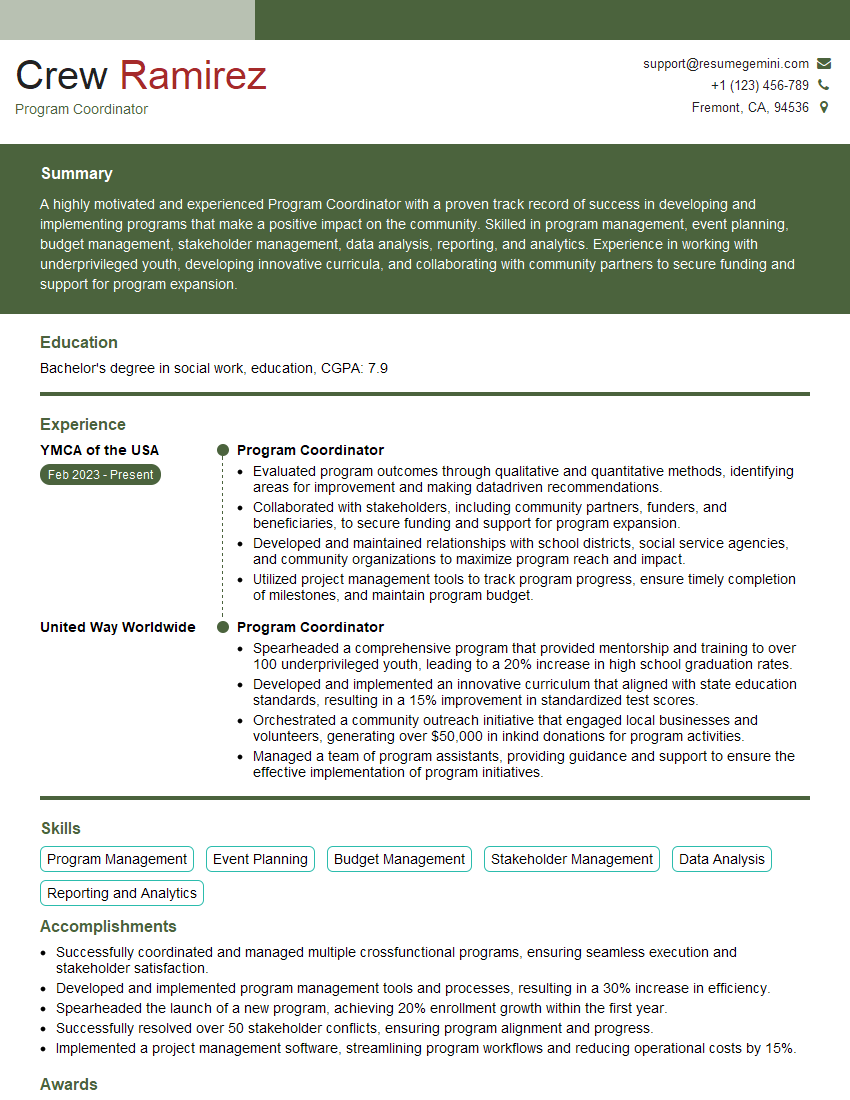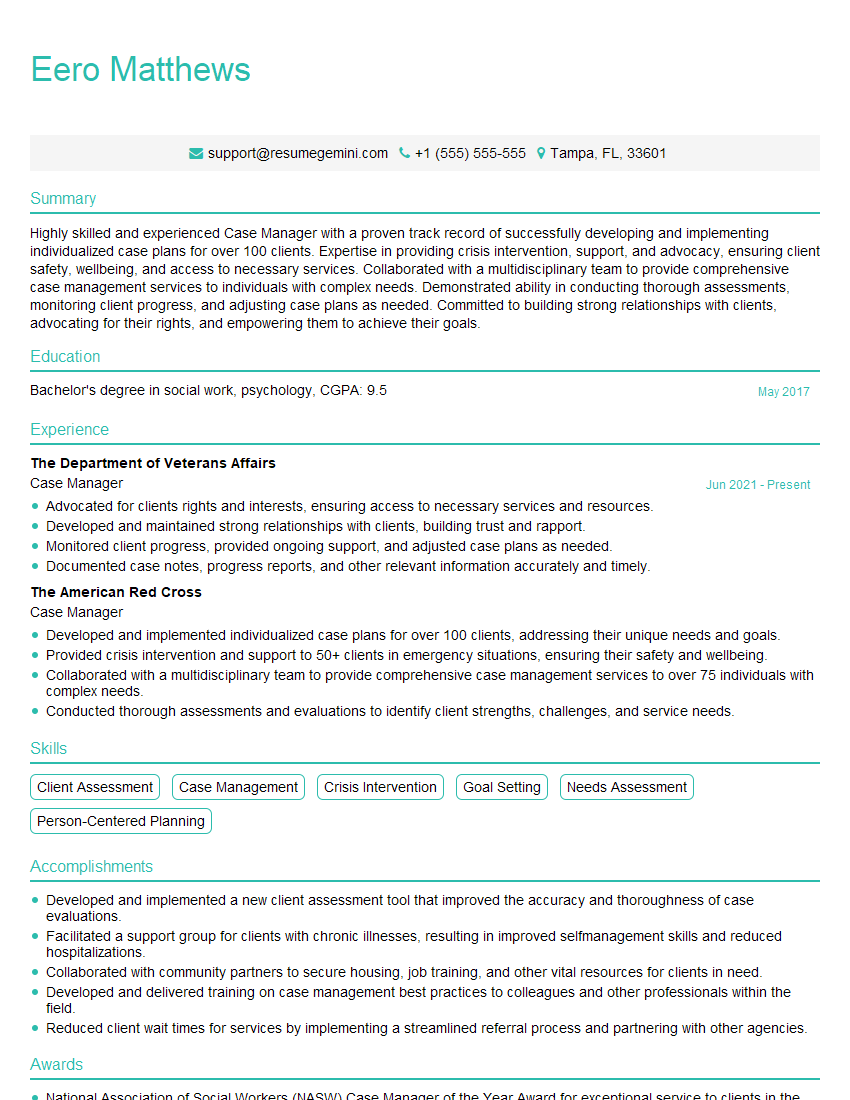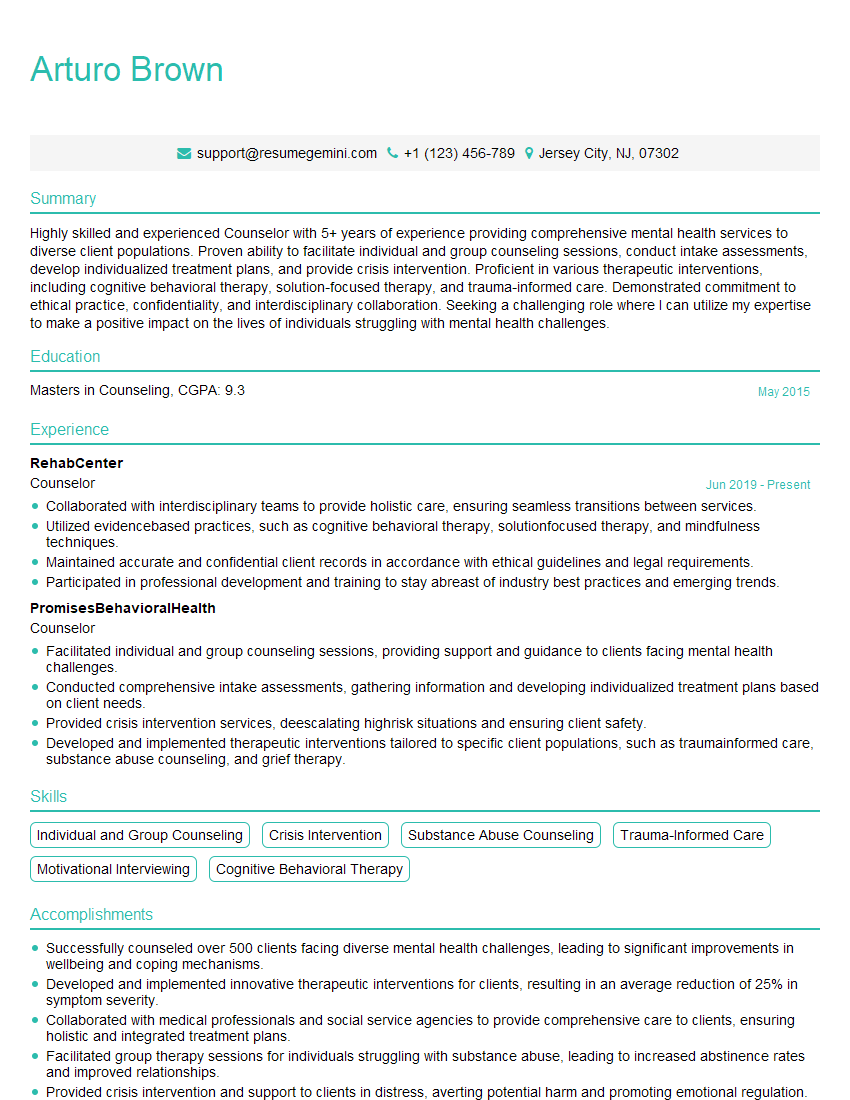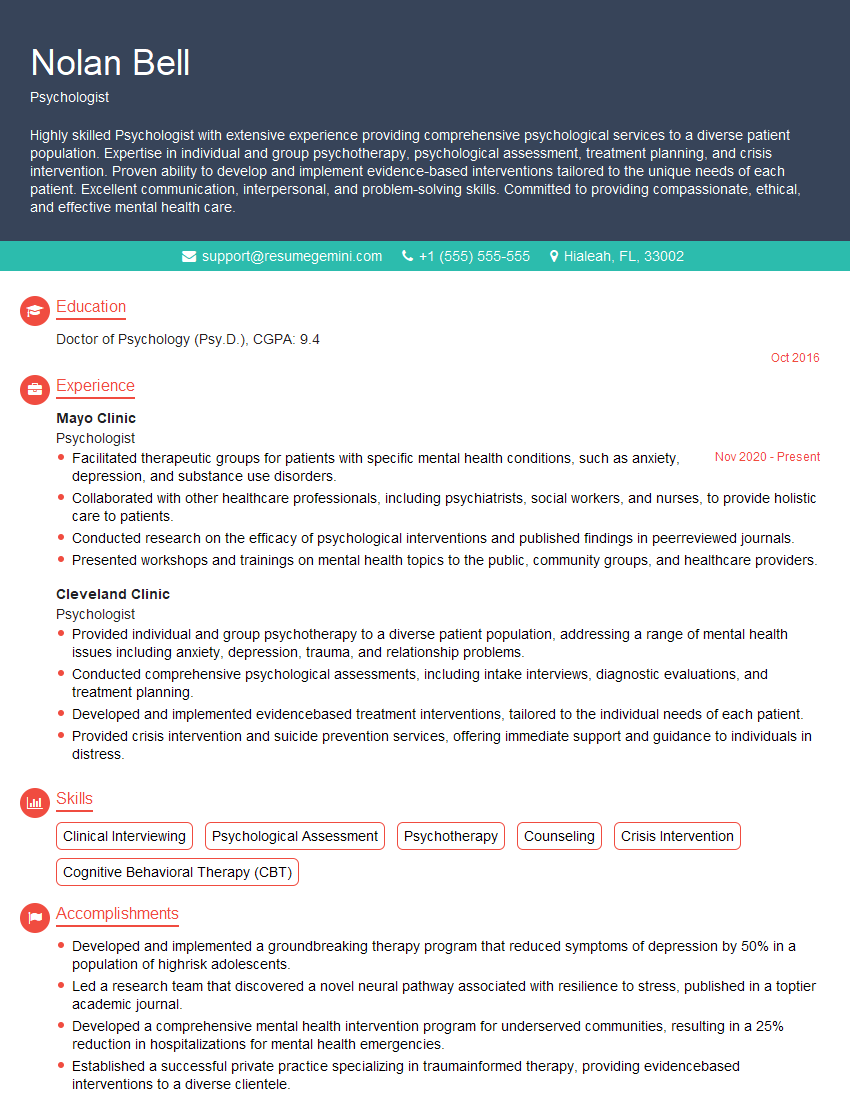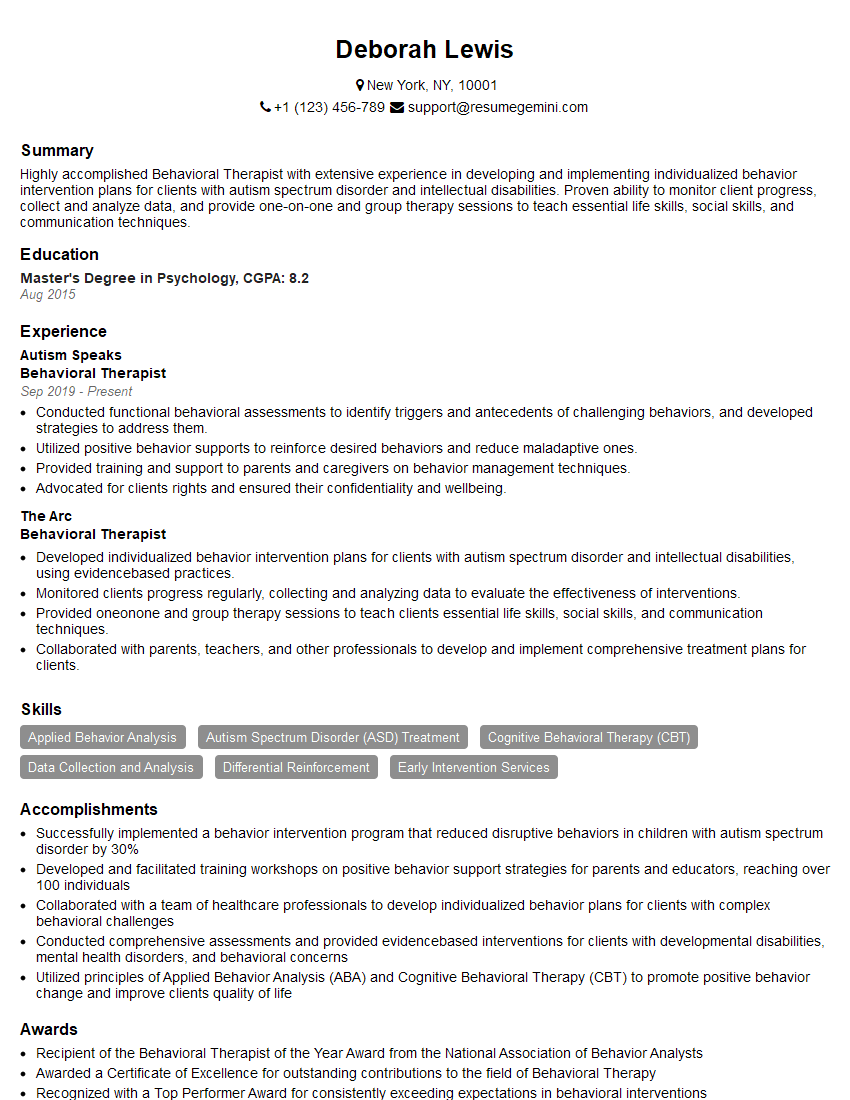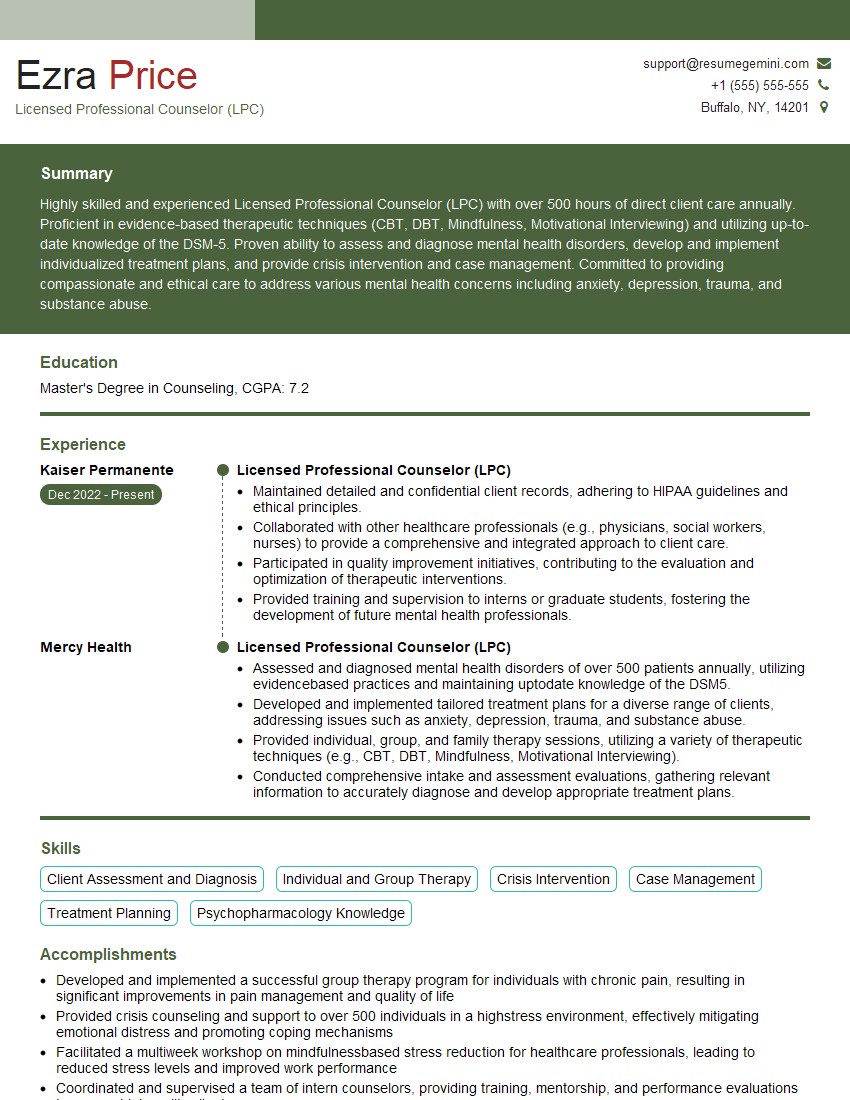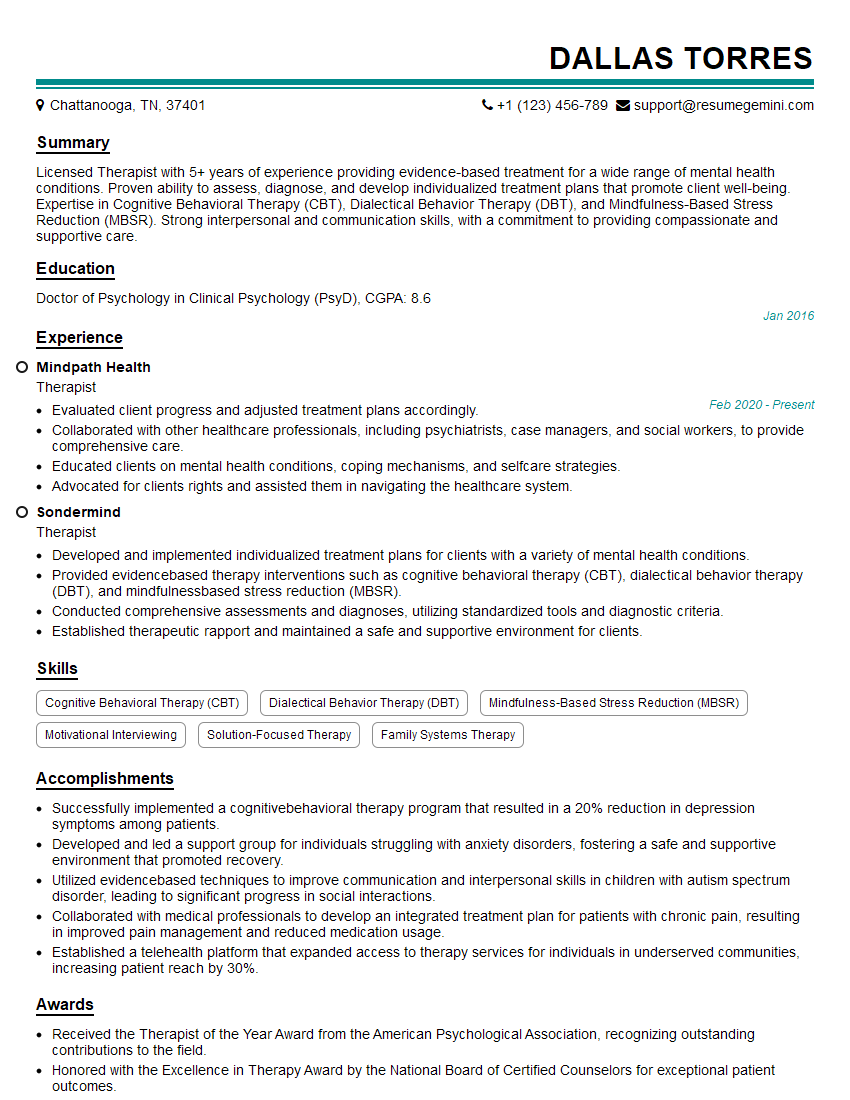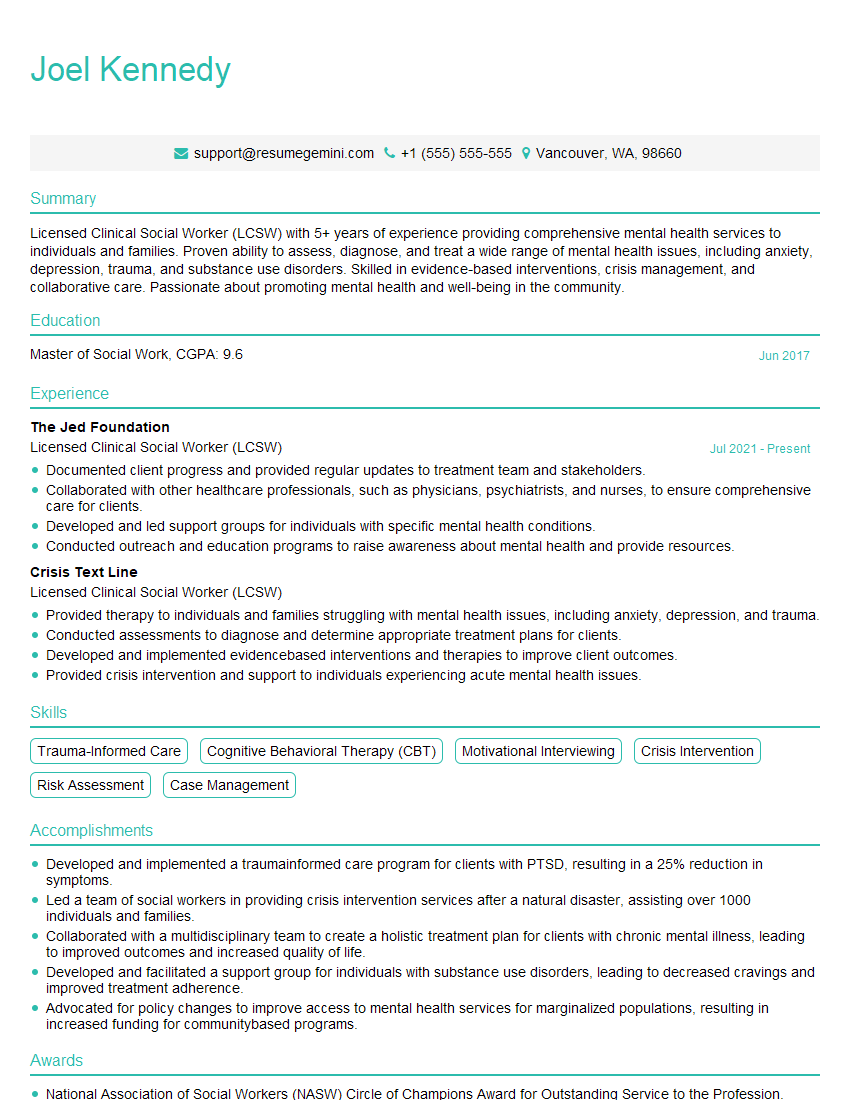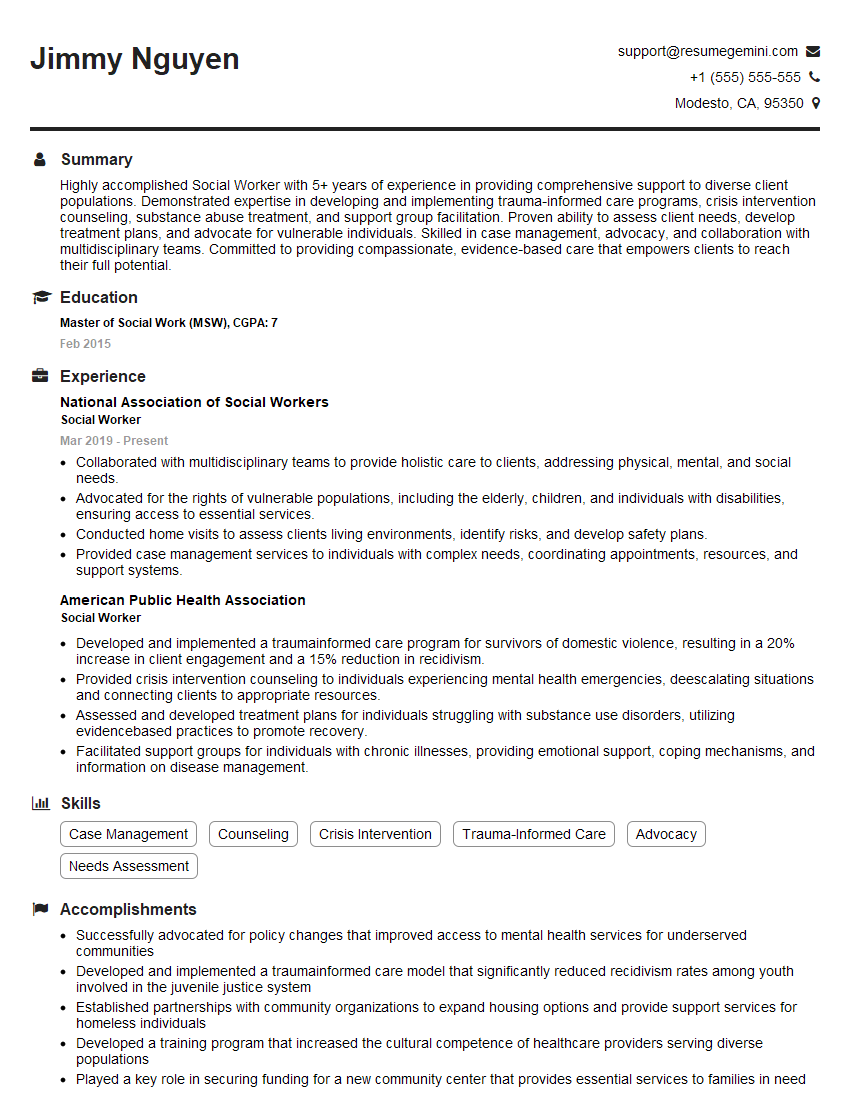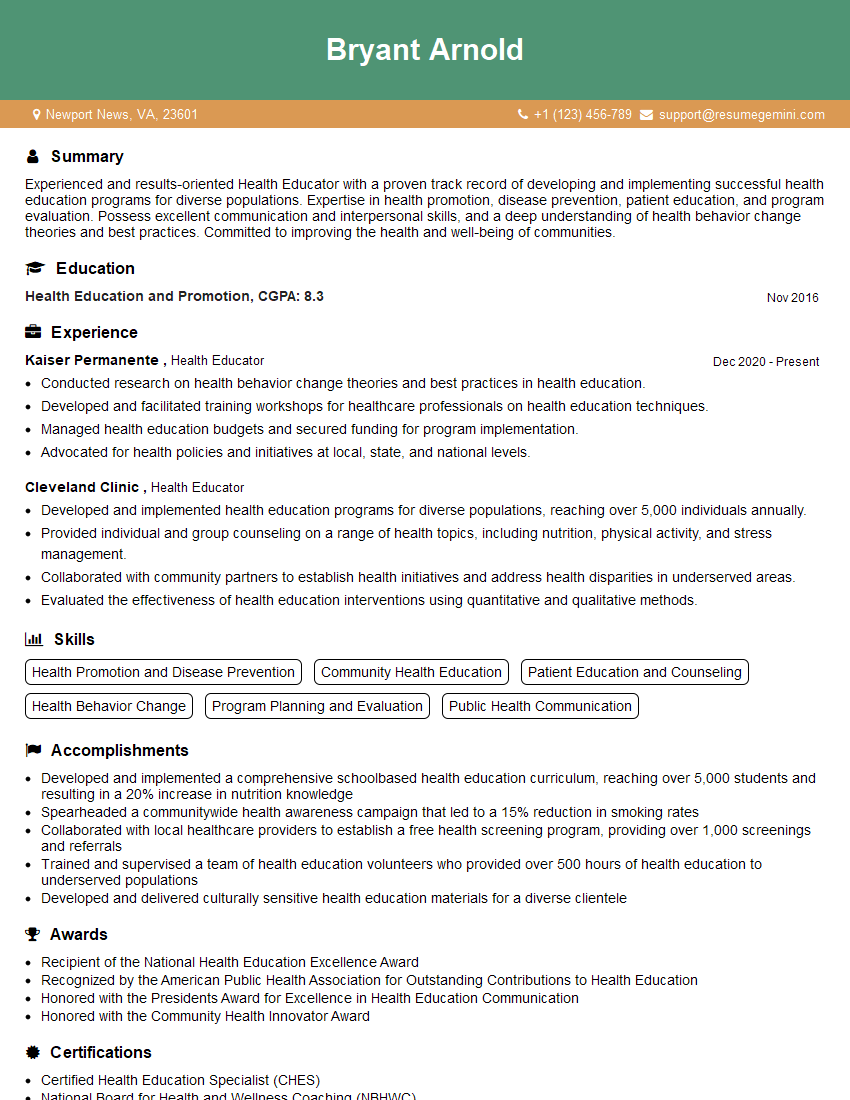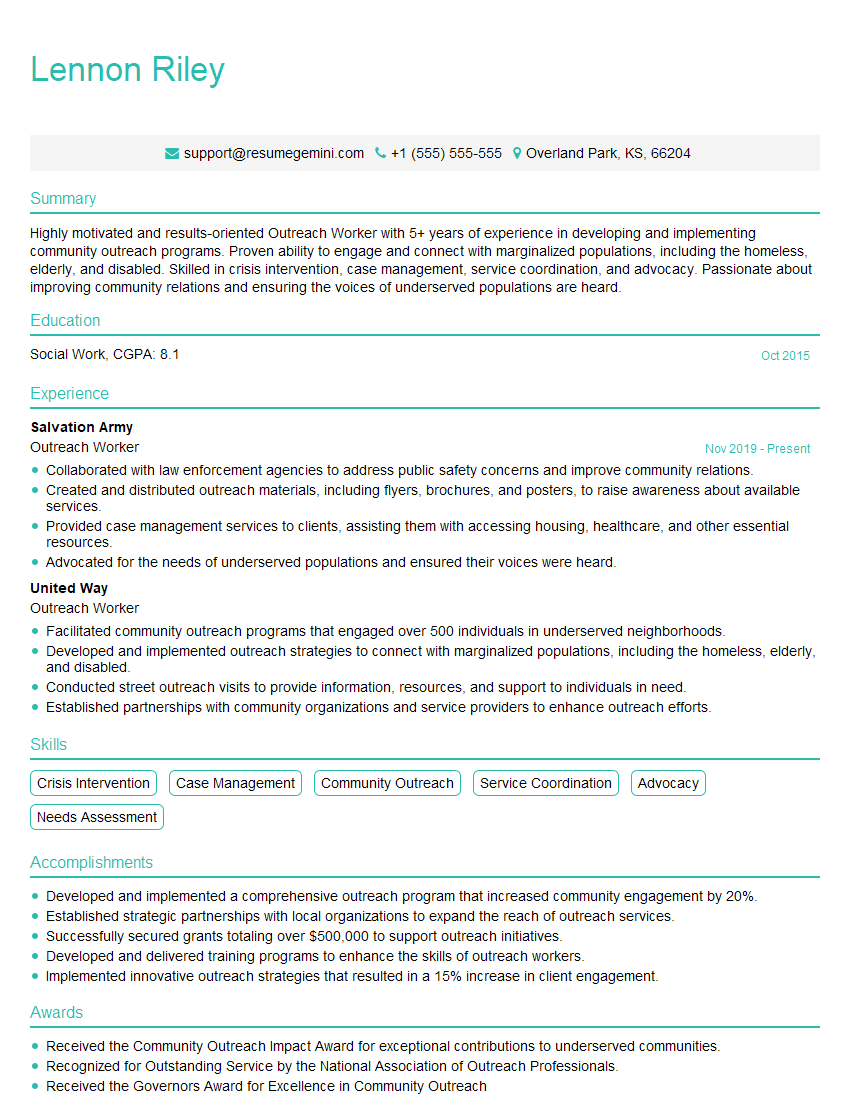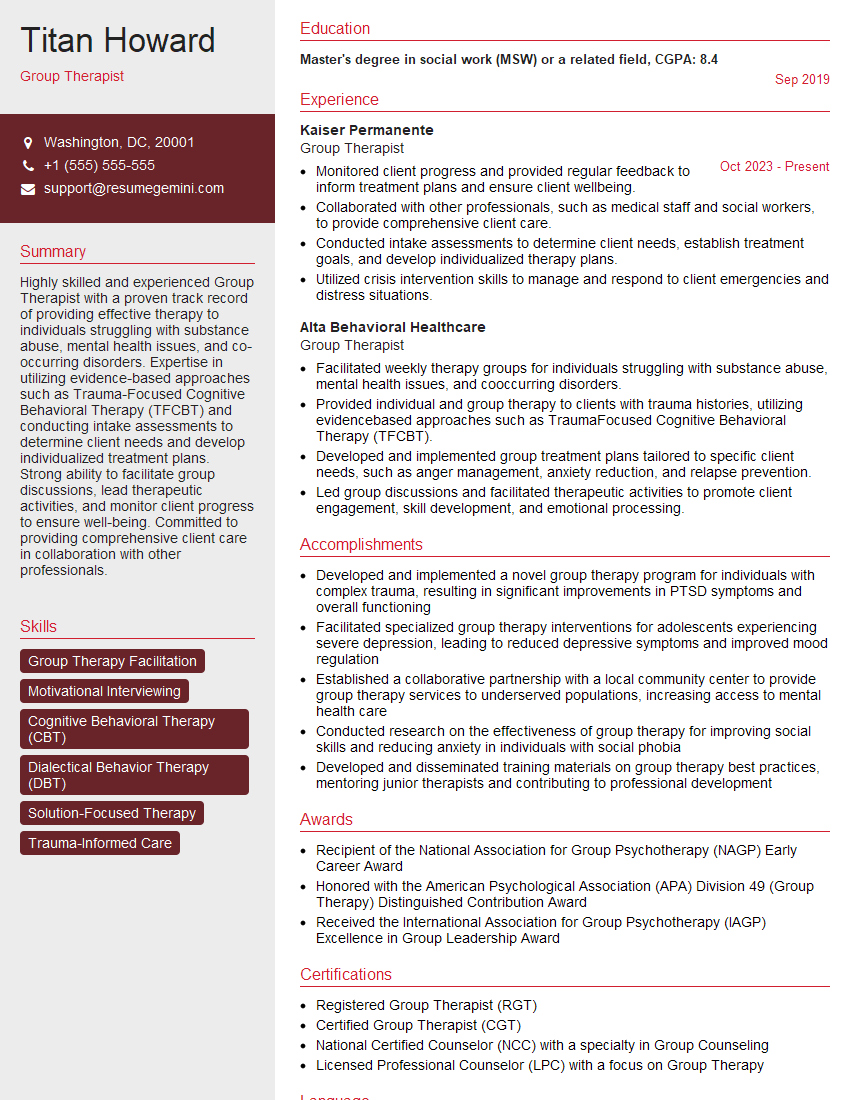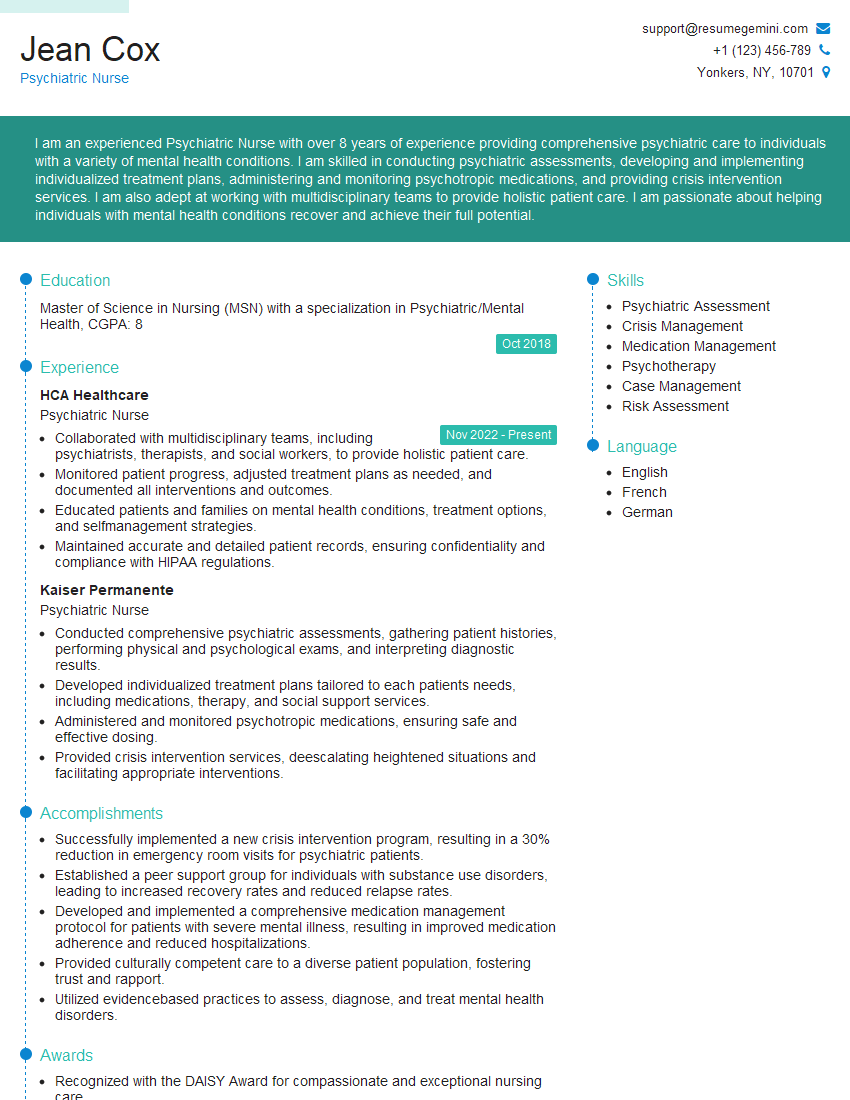Interviews are opportunities to demonstrate your expertise, and this guide is here to help you shine. Explore the essential Psychoeducation and Support Groups interview questions that employers frequently ask, paired with strategies for crafting responses that set you apart from the competition.
Questions Asked in Psychoeducation and Support Groups Interview
Q 1. Describe your experience facilitating support groups.
Facilitating support groups involves creating a safe and supportive environment where individuals with shared experiences can connect, learn from each other, and develop coping strategies. My experience spans over seven years, working with diverse populations including individuals struggling with anxiety, depression, trauma, and chronic illness. I’ve led both open and closed groups, utilizing various therapeutic approaches such as cognitive behavioral therapy (CBT) skills-building, mindfulness practices, and motivational interviewing. For example, in a group for individuals with anxiety, I facilitated sessions focused on identifying anxiety triggers, practicing relaxation techniques, and challenging negative thought patterns. I also prioritize building a strong group cohesion, fostering trust and empathy among members. This includes setting clear group guidelines, establishing confidentiality, and actively managing group dynamics to ensure everyone feels heard and respected.
Q 2. How do you adapt psychoeducation materials for diverse populations?
Adapting psychoeducation materials for diverse populations is crucial for effective intervention. This requires considering factors such as cultural background, language proficiency, literacy level, and socioeconomic status. For example, when working with a predominantly Spanish-speaking population, I ensure materials are translated accurately and culturally adapted. This might involve changing examples to reflect their cultural context or using imagery that resonates with their background. For individuals with low literacy, I use visual aids, simplified language, and interactive activities to enhance understanding. I also incorporate diverse perspectives and experiences into the materials to promote inclusivity and avoid perpetuating stereotypes. Furthermore, I always offer materials in accessible formats like large print or audio versions. The key is to create materials that are not only informative but also relevant and engaging for each specific population.
Q 3. Explain your understanding of the stages of group development.
Tuckman’s stages of group development provide a helpful framework for understanding the evolution of a support group. These stages are: Forming (initial uncertainty and dependence on the facilitator), Storming (conflict and power struggles emerge as members establish roles and boundaries), Norming (cohesion and cooperation develop as members agree on group norms and expectations), Performing (the group functions effectively, achieving its goals), and Adjourning (the group disbands). Understanding these stages helps me anticipate challenges and facilitate constructive group processes. For instance, during the storming phase, I proactively address conflicts, encourage open communication, and help members establish clear ground rules. In the performing stage, I focus on maintaining momentum, encouraging peer support, and promoting the application of learned skills in daily life. Recognizing the natural progression through these phases allows for a more effective and supportive group experience.
Q 4. What techniques do you use to manage challenging group dynamics?
Managing challenging group dynamics is a key skill in support group facilitation. Techniques I utilize include:
- Setting clear group guidelines at the outset, ensuring everyone understands expectations for respectful communication and participation.
- Active listening and empathy, showing understanding and validating members’ feelings.
- Mediation and conflict resolution, helping members navigate disagreements constructively.
- Redirection and refocusing, guiding the conversation back to the group’s purpose if it veers off track.
- Individual check-ins, providing support to members who may be struggling.
- Utilizing group contracts, collaboratively creating and maintaining expectations.
Q 5. How do you assess the effectiveness of psychoeducation interventions?
Assessing the effectiveness of psychoeducation interventions involves a multi-faceted approach. I utilize both qualitative and quantitative methods. Quantitative methods might include pre- and post-intervention questionnaires measuring knowledge, attitudes, and skills related to the target area. For example, a pre-post test design measuring anxiety levels in an anxiety management group would be helpful. Qualitative methods include gathering feedback through group discussions, individual interviews, and observations of group dynamics. This allows for a richer understanding of the intervention’s impact on participants’ experiences and well-being. Analyzing both quantitative data (e.g., changes in scores on standardized measures) and qualitative data (e.g., participants’ reflections on their learning and growth) provides a comprehensive evaluation of the intervention’s success. It’s vital to consider the practical application of learning, such as changes in daily routines and self-management practices.
Q 6. Describe your experience working with individuals with [specific diagnosis, e.g., anxiety, depression].
I have extensive experience working with individuals with anxiety. My approach is grounded in evidence-based practices, primarily CBT. I help clients identify their anxiety triggers, challenge negative thought patterns, and develop coping strategies. I also incorporate mindfulness techniques to help them manage their symptoms in the present moment. For example, I might work with a client to identify their anxious thoughts surrounding social situations, help them challenge the validity of those thoughts, and then practice relaxation techniques or exposure exercises to gradually reduce their anxiety. I frequently collaborate with other professionals, like psychiatrists, to ensure clients receive a holistic approach. Personalized treatment plans are critical, adapting to the individual needs and preferences of each client.
Q 7. What are some common challenges in delivering psychoeducation, and how do you overcome them?
Common challenges in delivering psychoeducation include:
- Limited time to cover substantial material.
- Varied learning styles and needs of participants.
- Maintaining engagement throughout the sessions.
- Addressing participant skepticism or resistance to change.
- Managing emotional responses within the group.
- Structuring sessions effectively, prioritizing key concepts and incorporating interactive activities.
- Employing multiple teaching methods catering to visual, auditory, and kinesthetic learners.
- Building rapport with participants and creating a safe space for sharing.
- Addressing concerns and questions directly and providing evidence-based information.
- Offering personalized support and resources to individuals as needed.
Q 8. How do you incorporate evidence-based practices into your psychoeducational approach?
My psychoeducational approach is firmly grounded in evidence-based practices. This means I rely on research findings and best practices to inform my methods and interventions. For example, when working with individuals struggling with anxiety, I incorporate techniques supported by extensive research, such as Cognitive Behavioral Therapy (CBT) principles. This involves helping clients identify and challenge negative thought patterns and develop coping mechanisms. I also utilize mindfulness-based stress reduction techniques, proven to be effective in managing anxiety symptoms. Furthermore, I regularly consult up-to-date research journals and attend professional development workshops to stay current on the latest evidence-based treatments and adapt my approaches accordingly. I also tailor my approach to the specific needs and preferences of each individual, recognizing that a ‘one-size-fits-all’ approach is rarely effective.
For instance, while CBT is a strong foundation, I might supplement it with elements of Acceptance and Commitment Therapy (ACT) for a client who also struggles with avoidance behaviors. The key is to be flexible and adapt the evidence-based framework to the unique circumstances of each individual.
Q 9. Explain the importance of confidentiality and ethical considerations in support groups.
Confidentiality and ethical considerations are paramount in support groups. Building trust is fundamental, and that trust hinges on the assurance that shared experiences and personal information will remain private. I explicitly address this at the beginning of each group, outlining my commitment to confidentiality and explaining the limitations (e.g., mandatory reporting of child abuse or imminent harm to self or others). I emphasize the importance of respecting each member’s privacy and avoid disclosing any details that could identify individuals outside the group.
Ethically, I adhere to the guidelines set by relevant professional organizations, such as maintaining appropriate professional boundaries, avoiding dual relationships (e.g., becoming friends with a group member), and ensuring informed consent for all group activities. This includes explaining the purpose of the group, the rules of engagement, and any potential risks or benefits involved. Regularly reviewing and reinforcing these principles throughout the group’s duration is crucial to maintain a safe and ethical environment.
Q 10. How do you ensure participant safety and well-being in a support group setting?
Participant safety and well-being are my top priorities. I create a safe space by establishing clear group guidelines, emphasizing respect and empathy, and proactively addressing any potential risks. This includes identifying and managing potential triggers for members, providing emotional support, and having a plan for dealing with crises or emergencies.
For example, if a member expresses suicidal ideation, I have a protocol in place to assess the risk level, provide immediate support, and, if necessary, connect them with crisis services or emergency contacts. I also build in mechanisms for members to seek individual support outside the group if needed. Regular check-ins and open communication ensure that any concerns are addressed promptly and effectively. The group environment itself is designed to be supportive rather than triggering. This includes creating a non-judgmental space where members feel comfortable sharing their experiences without fear of criticism or ridicule.
Q 11. What are the key components of a successful support group?
Successful support groups have several key components. First, a clear focus or theme is essential to provide structure and direction. This might be a specific mental health challenge, a shared life experience (e.g., grief, chronic illness), or a common goal (e.g., weight loss, stress management). Secondly, a skilled facilitator who can guide discussions, manage conflicts, and ensure everyone feels heard and valued is crucial.
A supportive and inclusive environment is also critical, encouraging open communication and mutual respect amongst members. Structure and process are important for building trust and creating predictability. This includes establishing ground rules, structuring the sessions (e.g., using icebreakers, check-ins, and activities), and providing clear expectations. Finally, the group needs to allow for both individual sharing and group interaction, so members feel connected and supported.
Q 12. Describe your experience with different support group models (e.g., open vs. closed groups).
I have extensive experience with both open and closed support groups. Open groups allow new members to join at any time, offering flexibility and continuity. This model is particularly suitable for ongoing support and when member turnover is expected. Closed groups, on the other hand, have a fixed membership, creating a sense of cohesion and intimacy. This fosters deeper relationships between members, allowing for a more profound level of trust and vulnerability. Closed groups are often more suitable for intensive, time-limited interventions.
The choice between these models depends on the specific needs and goals of the group. I’ve found that the benefits of each approach are often combined in the real world. For example, a closed group for people recovering from trauma might meet initially as a closed group to establish a sense of trust but then transition to an open group to allow for new members joining as others complete the process.
Q 13. How do you build rapport and trust with group members?
Building rapport and trust is a gradual process that starts from the first session. I begin by creating a safe and welcoming atmosphere. I clearly communicate the group’s purpose and expectations, emphasizing confidentiality and respect. I actively listen to members’ experiences, validating their feelings and perspectives, and demonstrating empathy.
I also use techniques like self-disclosure (sharing relevant personal experiences in an appropriate manner) to model vulnerability and build connections. Consistency and reliability in facilitating the group also foster trust. Members need to know they can count on the facilitator to provide a structured and supportive environment. The group’s early sessions are particularly important for creating the foundation for building relationships within the group.
Q 14. How do you handle conflict within a support group?
Conflict is inevitable in any group setting, but it can also be an opportunity for growth and learning. When conflict arises, I intervene using a calm and neutral approach. I guide members towards constructive communication, helping them express their feelings and perspectives without resorting to personal attacks. I use active listening, summarizing, and clarifying techniques to ensure everyone is heard and understood.
If the conflict escalates, I may temporarily interrupt the discussion, offering the opportunity for a brief break or individual check-ins to cool down. I might also utilize problem-solving techniques to help the group find a mutually acceptable resolution. A key principle is to always maintain impartiality and to focus on the issues at hand rather than assigning blame. Following a conflict, I make sure to check in with all involved parties to ensure everyone feels heard and respected, and the experience has been processed constructively.
Q 15. How do you address a member’s disclosure of suicidal ideation?
Addressing a member’s disclosure of suicidal ideation requires immediate and compassionate action. It’s crucial to prioritize their safety and well-being. My first step is to listen without judgment, validating their feelings and experiences. I would use open-ended questions like, “Can you tell me more about what you’re feeling?” to encourage them to express themselves. Then, I would directly assess the risk by asking about specific plans, means, and intent. This is not about prying; it’s about gathering information necessary to create a safety plan.
If there’s an immediate risk of harm, I would immediately contact emergency services (911 or the equivalent in the region) or a crisis hotline. Even if there’s no immediate plan, I’d work collaboratively with the member to develop a safety plan. This typically involves identifying triggers, coping mechanisms, and support systems, including friends, family, mental health professionals, and crisis resources. The safety plan is documented and revisited regularly. Importantly, I would emphasize that suicidal thoughts are treatable and recovery is possible, and I would offer to connect them with professional mental health services for further evaluation and treatment.
For example, I once had a group member who tearfully revealed overwhelming suicidal thoughts after a significant loss. By listening empathetically, assessing the risk, and collaborating to create a safety plan, involving her family and a therapist, we were able to effectively navigate the crisis and help her find hope and healing.
Career Expert Tips:
- Ace those interviews! Prepare effectively by reviewing the Top 50 Most Common Interview Questions on ResumeGemini.
- Navigate your job search with confidence! Explore a wide range of Career Tips on ResumeGemini. Learn about common challenges and recommendations to overcome them.
- Craft the perfect resume! Master the Art of Resume Writing with ResumeGemini’s guide. Showcase your unique qualifications and achievements effectively.
- Don’t miss out on holiday savings! Build your dream resume with ResumeGemini’s ATS optimized templates.
Q 16. What are your strategies for promoting active participation in support groups?
Promoting active participation in support groups requires creating a safe, supportive, and engaging environment. I use a multi-faceted approach. Firstly, I begin each session with a structured icebreaker to help members connect and feel comfortable. I facilitate discussions using techniques like open-ended questions, reflective listening, and summarizing to ensure everyone feels heard.
Secondly, I actively manage group dynamics. This includes setting clear ground rules about confidentiality and respect, addressing any conflicts constructively, and ensuring equitable participation. I might employ activities like role-playing or small group exercises to increase engagement. For example, I might assign a topic for members to discuss in small groups before bringing the insights back to the larger group.
Thirdly, I provide clear, consistent communication about group goals, expectations, and structure. I tailor the group content to the members’ interests and needs, regularly soliciting feedback to improve the group experience. Finally, I build rapport with members individually, fostering trust and making them feel safe to share their experiences.
Q 17. How do you measure the outcomes of support groups?
Measuring the outcomes of support groups involves using both quantitative and qualitative methods. Quantitative methods might include pre- and post-group assessments using standardized questionnaires or scales that measure symptoms, coping skills, or social support. For example, we might use the Patient Health Questionnaire-9 (PHQ-9) to assess depression severity before and after the group.
Qualitative methods focus on capturing the experiences and perspectives of group members. This often involves conducting individual interviews or focus groups after the support group concludes. We might use open-ended questions to understand how the group impacted their well-being, coping skills, and social connections. We might also review group session recordings and written feedback for further qualitative data analysis.
Analyzing both quantitative and qualitative data helps build a comprehensive understanding of the effectiveness of the support group, identifying areas for improvement and demonstrating its impact on members’ lives.
Q 18. Describe your experience developing psychoeducation materials.
My experience in developing psychoeducation materials is extensive. I usually begin with a thorough needs assessment, identifying the target audience’s knowledge level, learning styles, and cultural backgrounds. Then, I work on outlining the content, creating clear learning objectives, and structuring the material in a logical, engaging manner.
I use diverse formats such as handouts, presentations, videos, and interactive exercises. For instance, I created a series of short videos explaining anxiety management techniques, each focusing on a single, easy-to-understand concept. Accessibility is key; I always keep the language simple and avoid jargon. I also ensure that the materials are visually appealing, using clear fonts, images, and layouts to enhance readability and comprehension. Once developed, I test the materials with the target audience to get feedback and refine them before widespread use.
Q 19. How do you ensure that psychoeducation materials are culturally sensitive and accessible?
Ensuring cultural sensitivity and accessibility in psychoeducation materials requires a careful and deliberate process. Firstly, I involve individuals from diverse cultural backgrounds in the development and review process. This ensures that the materials resonate with the intended audience and avoid perpetuating stereotypes or biases.
Secondly, I use language that is inclusive and avoids jargon. I consider the literacy levels of the target audience and use plain language. I also ensure that the materials are available in multiple languages and formats to cater to different needs, such as providing large print versions for visually impaired individuals or audio versions for those with reading difficulties. Finally, I consider the cultural context, making sure that the information presented is relevant and appropriate for the target audience’s cultural background and beliefs. For example, when creating materials for an immigrant population, I’d incorporate culturally relevant examples and address specific cultural challenges.
Q 20. What are some common misconceptions about mental health that you address in psychoeducation?
Many common misconceptions surround mental health. In my psychoeducation sessions, I frequently address several key areas. One common misconception is that mental illness is a sign of personal weakness. I emphasize that mental health conditions are medical illnesses, similar to physical ailments, and are not a reflection of character flaws.
Another frequent misconception is that mental illness is incurable. I explain that while some conditions may be chronic, many are treatable, and recovery is possible with appropriate support and intervention. I also address the stigma surrounding seeking mental health help, encouraging open conversations and emphasizing that it’s a sign of strength, not weakness, to ask for help. Finally, I explain the difference between normal stress and a diagnosable mental health disorder, highlighting the importance of seeking professional help when symptoms significantly impact daily functioning.
Q 21. How do you adapt your communication style to different learning styles?
Adapting my communication style to different learning styles is crucial for effective psychoeducation. I acknowledge that people learn in various ways – visually, auditorily, kinesthetically, and through reading and writing. I use a multimodal approach, incorporating diverse methods in my presentations and materials.
For visual learners, I use diagrams, charts, and videos. For auditory learners, I incorporate discussions, audio recordings, and group work. Kinesthetic learners benefit from hands-on activities, role-playing, and movement-based exercises. For those who prefer reading and writing, I provide detailed handouts and written summaries. I also actively gauge participants’ learning styles through observation and by asking questions that help me understand their preferences. This enables me to tailor the delivery method and adapt my teaching techniques to best suit each individual and the overall group.
Q 22. Describe a time you had to deal with a difficult group member. How did you handle the situation?
Handling difficult group members requires a delicate balance of empathy and firm boundaries. In one instance, a participant consistently dominated conversations, interrupting others and dismissing their perspectives. This behavior disrupted the group’s dynamic and prevented others from fully participating. My approach involved a combination of strategies. First, I privately spoke with the individual, acknowledging their passion and valuable contributions, but highlighting how their dominating style was affecting the group’s flow. I emphasized the importance of active listening and respectful dialogue, suggesting techniques like taking a breath before speaking or summarizing others’ points before sharing their own. Secondly, in subsequent group sessions, I subtly guided the conversation back to other members, using techniques like “Who else would like to share their experience?” or directly asking other participants questions. Finally, I reinforced positive behavior by verbally acknowledging respectful interactions. This multi-pronged approach addressed the individual’s needs while protecting the group’s overall well-being. The result was a gradual shift towards more balanced participation and a more positive group environment.
Q 23. What are your strategies for engaging reluctant participants in support groups?
Engaging reluctant participants requires understanding their hesitation. Sometimes, it’s fear of judgment, vulnerability concerns, or past negative experiences with group settings. My strategies involve creating a safe and welcoming environment. This includes explicitly stating confidentiality (within the legal and ethical limits), emphasizing the non-judgmental nature of the group, and starting with icebreaker activities that are lighthearted and low-pressure. I actively solicit input from quieter members, asking direct questions like, “What’s been your experience with this?” or, “How has this impacted you?” I also encourage peer support, suggesting others in the group might have had similar experiences and offering the chance to connect one-on-one before broader participation. For those who are still hesitant, offering individual check-ins outside the group provides a stepping stone towards feeling more comfortable in the larger group setting. It’s a journey, and patience is key; it’s important to remember that participation is a process, not a destination.
Q 24. How do you maintain your own well-being while working in a demanding role?
Self-care is paramount in this demanding role. Burnout is a real risk, and I actively prioritize strategies to prevent it. This includes maintaining a healthy work-life balance. I set clear boundaries between work and personal time, making sure I take regular breaks throughout the day and adhering to a consistent schedule, which helps me to switch off at the end of the day. I also prioritize physical health through regular exercise and mindfulness practices like meditation, ensuring I get sufficient sleep. Regular supervision and peer support are crucial for processing emotionally challenging material and preventing emotional exhaustion. Additionally, engaging in activities outside of work, such as hobbies or social interactions with friends and family, allows me to recharge and maintain a sense of perspective. I view self-care not as a luxury but as a necessary component of providing effective and compassionate care to others.
Q 25. How do you collaborate with other professionals (e.g., therapists, doctors) to provide comprehensive care?
Collaboration with other professionals is essential for providing holistic care. I regularly communicate with therapists, doctors, and other healthcare providers to ensure a coordinated approach. This often involves attending case conferences, sharing relevant information (while maintaining confidentiality and adhering to ethical guidelines), and integrating their input into the support group sessions. For example, I might discuss a participant’s progress with their therapist to get their perspective on the individual’s response to the psychoeducational material. Conversely, information gathered during group sessions, such as identified coping mechanisms or challenges, can inform their clinical work. Open and honest communication is paramount for building trust and ensuring a comprehensive approach to care that prioritizes the client’s well-being.
Q 26. What are the legal and ethical implications of sharing information from support groups?
Legal and ethical implications of sharing information from support groups are stringent. Confidentiality is paramount. HIPAA regulations in the US, and similar regulations in other countries, strictly limit the disclosure of Protected Health Information (PHI). Sharing information outside the context of the group, even in an anonymized form, could lead to legal repercussions and ethical breaches. The only exceptions would be situations involving mandated reporting (such as threats of self-harm or harm to others). Even then, sharing is limited to the necessary minimum to ensure safety. Transparency about confidentiality limits is crucial at the beginning of every group, reassuring participants that their privacy is respected within the group context. Consent and informed decision-making are fundamental principles.
Q 27. Describe your experience with different assessment tools used to measure progress in support groups.
I utilize various assessment tools to measure progress, tailored to the specific group’s goals and the needs of the participants. These include standardized questionnaires like the Outcome Rating Scale (ORS) to assess overall well-being and the Patient Health Questionnaire-9 (PHQ-9) to assess depression severity. We also employ qualitative measures like feedback forms and group discussions to get a richer understanding of progress. Analyzing the pre and post-group scores of these assessments, coupled with observations from group sessions, provides a comprehensive evaluation of individual and group-level changes. For example, a reduction in PHQ-9 scores combined with increased self-reported use of coping mechanisms discussed in the group sessions would indicate positive progress. It’s crucial to remember that these tools provide a snapshot of progress, not a definitive measure of success, and should be interpreted within the larger context of individual circumstances.
Q 28. What are your strengths and weaknesses in facilitating psychoeducation and support groups?
My strengths include creating a safe and supportive group environment, facilitating open communication, and tailoring psychoeducation to meet diverse learning styles. I’m adept at managing group dynamics and mediating conflicts constructively. My ability to build rapport with participants, fostering trust and encouraging self-disclosure, is a key asset. However, I recognize that maintaining objectivity, particularly when dealing with emotionally charged content, can be challenging. I’m also continuously working on further developing my skills in working with participants with severe mental health disorders or complex trauma histories, recognizing that this often necessitates more specialized interventions than I’m currently trained to provide. This is an area where I actively seek out continuing education and collaboration with colleagues with specialized training. This continuous self-reflection and commitment to professional development ensures I can consistently provide the best possible support to participants.
Key Topics to Learn for Psychoeducation and Support Groups Interview
- Understanding Psychoeducation: Defining psychoeducation, its core principles, and its role in mental health treatment. Explore different models and approaches to delivering effective psychoeducation.
- Facilitating Support Groups: Mastering group dynamics, communication techniques, and conflict resolution strategies within a support group setting. Understand the ethical considerations and boundaries involved.
- Developing Curriculum and Materials: Designing engaging and informative psychoeducational materials tailored to specific populations and mental health conditions. This includes understanding learning styles and adapting materials accordingly.
- Assessing Group Needs and Progress: Employing appropriate assessment tools and methods to evaluate the effectiveness of psychoeducation and support group interventions. Understanding how to track individual and group progress.
- Working with Diverse Populations: Addressing the unique needs and challenges of diverse populations within psychoeducation and support groups, including considerations for cultural sensitivity and inclusivity.
- Collaboration and Teamwork: Understanding the importance of interprofessional collaboration in providing comprehensive mental health care. This includes working effectively with psychiatrists, therapists, and other healthcare professionals.
- Ethical and Legal Considerations: Understanding relevant ethical guidelines, confidentiality protocols, and legal frameworks related to the provision of psychoeducation and support group services.
- Practical Application: Develop case studies illustrating how you would apply these concepts in real-world scenarios. Consider different client presentations and group dynamics.
Next Steps
Mastering psychoeducation and support group facilitation opens doors to rewarding careers in mental health, offering opportunities for significant positive impact on individuals and communities. To maximize your job prospects, creating a strong, ATS-friendly resume is crucial. ResumeGemini is a trusted resource that can help you build a professional resume that showcases your skills and experience effectively. ResumeGemini provides examples of resumes tailored to Psychoeducation and Support Groups to help guide you in crafting a compelling application. Invest time in building a compelling resume – it’s your first impression and a key step towards landing your dream job.
Explore more articles
Users Rating of Our Blogs
Share Your Experience
We value your feedback! Please rate our content and share your thoughts (optional).
What Readers Say About Our Blog
This was kind of a unique content I found around the specialized skills. Very helpful questions and good detailed answers.
Very Helpful blog, thank you Interviewgemini team.
